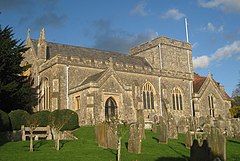Boughton Monchelsea
| Boughton Monchelsea | |
|---|---|
 St Peter's Church | |
 Boughton Monchelsea Location within Kent | |
| Population | 3,313 (2011 Census)[1] |
| District |
|
| Shire county | |
| Region | |
| Country | England |
| Sovereign state | United Kingdom |
| Post town | Maidstone |
| Postcode district | ME17 |
| Police | Kent |
| Fire | Kent |
| Ambulance | South East Coast |
| UK Parliament | |
Boughton Monchelsea is a village and civil parish[2] in the borough of Maidstone in Kent, England. The civil parish lies on a ragstone ridge situated between the North Downs and the Weald of Kent and has commonly been called Quarry Hills. The village itself is located 3 miles (5 km) south of the town of Maidstone.
History[]

The village name comes from a corruption of the name of the Norman family given the manor after the Conquest: Montchensie who held the manor until 1287[3] and the Anglo Saxon Boc Tun (Beech Tree settlement). The village is mentioned in the Domesday Book as Boltone, then Bouton, Bocton, and probably via Bocton de Montchensie to the current Boughton Monchelsea. The suffix using the family name seems to have been added in this area of Kent, possibly to differentiate multiple Boctuns.[4]
Some of the earliest history of Boughton Monchelsea is in the Iron Age settlement at Quarry Wood Camp (Camp Field). There are traces of an outer rampart on Parsonage Farm (on the edge of Park Wood) constructed by the Belgae about 40 AD, possibly as a defence against the Roman invasion in 43 AD.
The foundations of a Roman bathhouse were discovered in 1841 near Brishing Court, also a Roman villa at Brishing and a cemetery at Lockham. The quarries were worked extensively in Roman times and the villa and bathhouse could well have belonged to the quarry owner. Ragstone (a type of sandstone) was worked here; stone for the building of Westminster Abbey, the present-day Houses of Parliament and the repair of Rochester Castle came from here. The last quarry closed in 1960.
The village church, dedicated to St Peter, was built around 1100. There is a notable fourteenth century Lych-gate at the Churchyard.[5]
Local amenities[]
The village has a village green, a primary school, a village hall, a recreation ground, one public house a post office and a community arts centre The Maidstone Art Centre which is situated at Marlpit Farm in Wierton Road among its amenities.
The 16th-century Elizabethan stone-built former manor house, Boughton Monchelsea Place,[6] is situated in a private deer park and remains a private dwelling although it is occasionally opened for commercial use as a venue for weddings and business conferences.
A similar property at nearby Wierton Place has in recent years operated as a polo and country club as well as an exclusive out-of-town nightclub. Prior to that it was the official residence of judges when on circuit at Maidstone Crown Court.[3]
Other historic houses include the Grade II listed Tanyard,[7] Brishing Court and Lewis Court.
The Cock Inn, dating back to 1568, is situated at the junction of Heath Road and Brishing Lane. Featured in the classic 1949 film Kind Hearts and Coronets starring Sir Alec Guinness and Dennis Price, The Cock is a typical old English pub featuring inglenooks, exposed beams and low ceilings.
Boughton is also the home of the artist Graham Clarke.[citation needed]
Notable residents[]
- Sir Anthony St Leger, Master of the Rolls in Ireland, of Wierton House, which he bought from the Norton family, lived here in c. 1610-13.
- Thomas Musgrave Joy, painter, was born here in 1812.[8]
- Benjamin Remington, first-class cricketer
- Michael Remington, first-class cricketer
- William Tomkin (William Stephen Tomkin) was born in the village on 25 November 1860 to farmer William Stephen Tomkin (Snr) and Elizabeth Harrison.[9]
Trivia[]
- Westminster Abbey and the present-day Houses of Parliament are built from ragstone quarried in Boughton Monchelsea.[citation needed]
- Iden Farm Cottage in the parish, won the Housebuilding category in the 2005/2006 Kent Design Awards.[10]
Business[]
Creative Vinyl Art are local sign makers and installers who create a variety of signage and livery for vehicles, shop fronts and homes in the Maidstone area. They are situated at unit 15 at the Marlpit Farm Complex
The kit car manufacturer GKD Sports Cars is based in Boughton Monchelsea with its workshops in nearby Lenham.
References[]
- ^ "Civil Parish 2011". Neighbourhood Statistics. Office for National Statistics. Retrieved 15 September 2016.
- ^ Parish council website Archived April 18, 2006, at the Wayback Machine
- ^ Jump up to: a b The Kent Village Book Alan Bignell 1986 ISBN 1-85306-571-4
- ^ Village name origination
- ^ How to Study an Old Church, A.Needham, pub Batsford. Page 8.
- ^ Boughton Monchelsea Place
- ^ "Tanyard". British Listed Buildings.
- ^ Suzanne Fagence Cooper, ‘Joy, Thomas Musgrave (1812–1866)’, Oxford Dictionary of National Biography, Oxford University Press, 2004 accessed 5 Oct 2013
- ^ From family records, and Harrison of Ightham published by Oxford University Press in 1928
- ^ "Top design award for converted rail shed". www.kentonline.co.uk. 2 December 2005. Retrieved 16 January 2014.
External links[]
![]() Media related to Boughton Monchelsea at Wikimedia Commons
Media related to Boughton Monchelsea at Wikimedia Commons
- Borough of Maidstone
- Villages in Kent
- Civil parishes in Kent
